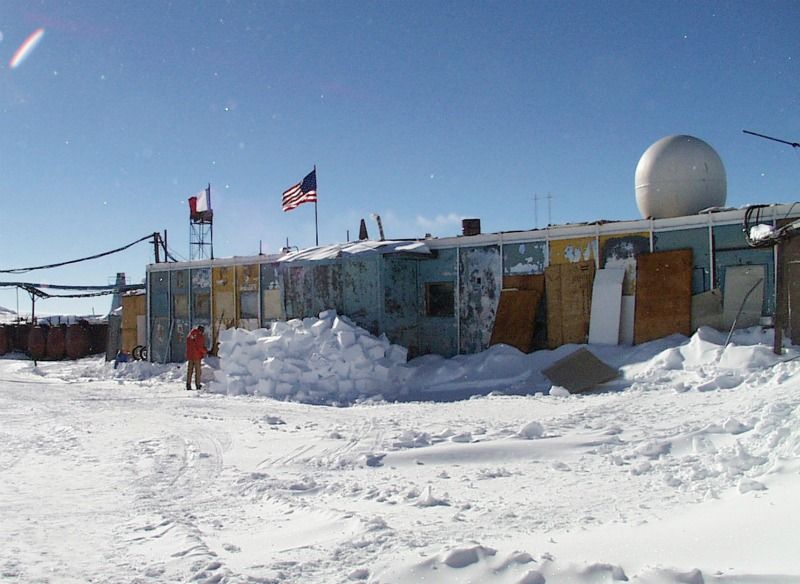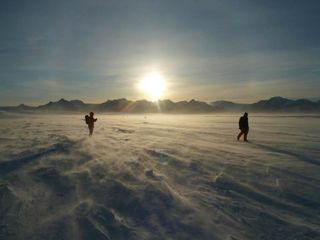
Russian Scientists Poised to Reach Ice-Buried Antarctic Lake

At a tiny outpost in the middle of Antarctica, Russian scientists are poised to become the first humans to reach a massive liquid lake that has been cut off from the sunlit world for millennia, and may house uniquely adapted life forms that are new to science.
Researchers are racing against the fast-approaching bitter cold and total darkness of Antarctic winter to complete a drill hole to Lake Vostok, one of the largest lakes on Earth, and the largest of the nearly 400 ice-buried lakes discovered on the frigid continent so far.
The researchers are not lost, nor is there evidence that anything sinister is afoot at Vostok Station, contrary to reports from other news outlets that suggest the scientists are in danger or missing.
It's an effort that began more than 10 years ago, and one that has been plagued by difficulties — and this season, the stakes are higher than ever. If they don't reach the lake before they are forced to leave for the winter, the Russian team will be forced to wait two more years to sample water from the lake, and discover what may be living in it.
The project is a product of serendipity. The colossal lake was discovered beneath a pre-existing drill project, and, although the Russians were the first to begin drilling to a hidden Antarctic lake, they may not be the first to sample one. Teams from the United States and the United Kingdom are nipping at their heels, poised to begin drilling with specially designed equipment as early as fall 2012. However, scientists from U.S. and British projects say it is not a race, and there is enormous scientific value in all three projects. [Race to the South Pole in Images]
Lake Vostok, roughly the size of Lake Ontario, lies in the middle of the East Antarctic Ice Sheet, and is buried beneath 2 miles (3.7 kilometers) of ice. The lake itself is likely almost as old as the ice sheet that covers it — around 14 million years old — and the water within could be 1 million years old, according to rough estimates.
Scientists suspect that Vostok and other Antarctic lakes, long secreted beneath the ice, are home to cold-loving organisms that have been left to their own evolutionary devices for hundreds of thousands of years.
Sign up for the Live Science daily newsletter now
Get the world’s most fascinating discoveries delivered straight to your inbox.
New life
"I think we'll find unique organisms," said John Priscu, a microbiologist at the University of Montana, and a veteran Antarctic researcher.
Priscu has studied the microbial life inside Antarctica's ice for decades, and has been corresponding with the Russian team at Vostok through headquarters in St. Petersburg.
The work had been progressing well, Priscu said. The latest press release from Russia's Arctic and Antarctic Research Institute, issued Jan. 13, said that drilling began this season on Jan. 2, progressed by 5.7 feet (1.75 meters) a day, and was halted on Jan. 12.
Priscu said the team stopped to take measurements and to switch drills from a large ice-coring drill to a smaller thermal drill designed to melt through the final 16 to 32 feet (5 to 10 meters) of ice that remain. [Stunning Photos of Antarctic Ice]
"This was the plan, but when you're in the field, things can change," Priscu said. He last corresponded with the team on the ice, via St. Petersburg scientists, two or three weeks ago. The Vostok team is evidently still in close contact with headquarters in Russia, and, because of the grueling pace and high-pressure nature of the work, are keeping further details close.
"This has never been done before," Priscu told OurAmazingPlanet. "It's a one-of-a-kind drill, a one-of-a-kind borehole, and a one-of-a-kind lake, so I'm sure they're making decisions on the fly all the time."
Although there is a decent chance the team can breach Lake Vostok this season, time is running short. Temperatures have already dropped below minus 40 degrees Fahrenheit (minus 40 degrees Celsius) at Vostok Station, and the team must leave before conditions get so cold that aircraft can't operate, Priscu said — the first week of February at the very latest.
(The station has the dubious honor of recording the coldest temperature on Earth — minus 129 degrees F (minus 89 degrees C), in July 1983.)
Even if they do succeed, researchers won't be able to get their hands on samples of lake water until next austral summer, in late 2012, because of the type of drill they're using.
In fact, their drill wasn't designed to reach a lake at all, and, when drilling began at Vostok Station in 1970, nobody had any inkling of what lay beneath the ice.
"They didn't know there was a lake there," Priscu said. At the time, nobody knew there were lakes in Antarctica at all.

Happy accidents
In the early '70s, the Soviets began some of the first-ever ice-coring projects at Vostok Station, drilling deep into the ice sheet to peer back into climatic conditions stretching back over 420,000 years. Air bubbles trapped in thin layers of the ice provide a molecular snapshot of atmospheric conditions from year to year.
Although aerial and other data gathered in the late '60s and '70s indicated there was water beneath Antarctica's ice, Lake Vostok was only officially described in the scientific literature in the mid-1990s, with the dawn of finer satellite and remote-sensing technology.
It turned out the Vostok Station drill was set up right over the southern tip of the giant lake. Roughly 155 miles (250 km) long and 50 miles (80 km) wide in places, the lake is shaped like a longer and skinnier version of Greenland. Its waters are more than 1,600 feet (500 m) deep in places.
The Russians have been drilling toward the lake since at least 1999, but equipment failures and fears of contaminating the pristine lake have hampered the project. [10 Most Pristine Places on Earth]
Last season, the team came agonizingly close to reaching the water, but winter's advance forced them to stop short.
Once they do pierce the bottom of the ice sheet with a hole about 5 inches (13 cm) across, lake water will shoot some 160 to 330 feet (50 to 100 m) up through the borehole, Priscu said, because the lake is under pressure, and poking a hole in its icy covering will be akin to poking a hole in a can of soda.
Once this happens, the lake water must be left inside the borehole over the winter to freeze before scientists can retrieve samples, since the drill is designed to fetch only ice instead of liquid.
Trouble in drill city
Because the drill is located over relatively shallow waters, and because of its sampling method, Priscu said the project will only allow scientists to get a peek at waters from the surface of the lake.
"That's like going out to one of the Great Lakes and putting a bucket over the side of a boat, and sampling it and saying, 'This is what's in the lake,'" he said. "That's not a very representative sample."
"It's not the most desirable part of the lake," he added, "but if they hadn't hit this spot this whole emergent field of subglacial science probably wouldn't be where it is."
In addition, there are concerns about contamination of the samples. Ice-core drill rigs commonly use jet fuel to keep the holes from freezing over, and previous analysis on samples taken from similar set-ups in Greenland were sullied by the drill fluid.
However, because the jet fuel is less dense than lake water, it won't slide down through the borehole and contaminate the lake itself.
And in addition to facing technological hurdles, the Russians have some friendly competition in the Antarctic lake scene. Teams from the United States and the United Kingdom are set to begin their own drilling projects to long-buried Antarctic lakes, and have the advantage of state-of-the-art equipment designed specifically for the task.

Both the British and American teams are using hot-water drills which can reach their targets in mere days, and have the ability to retrieve liquid samples, which can be brought back to the surface within 24 hours.
In addition, the equipment will allow researchers to fetch water samples throughout the lake's depth, including sediment at the bottom.
As things stand now, it appears that British researchers will likely be the first to put a sample of ancient, buried lake water under a microscope.
Engineers with the British Antarctic Survey recently hauled nearly all of the necessary drilling equipment — roughly 70 tons' worth — to the site of Lake Ellsworth, a lake buried 2 miles (3 km) beneath the ice in West Antarctica, and are poised to begin drilling at the start of the next Antarctic field season.
The American project, dubbed WISSARD, or Whillans Ice Stream Subglacial Access Research Drilling, is aimed at a subglacial lake also in West Antarctica, which is a slightly different animal. The lake fills and drains more regularly than Lake Ellsworth or Lake Vostok, and its waters are thus far younger.
Priscu, one of the project's chief scientists, said things are moving quickly. Just this week, the project's drill left New Zealand on a ship bound for Antarctica, but 10 shipping containers of equipment still remain in New Zealand, and need to be flown in. Once everything is in Antarctica, it must be hauled overland to the Lake Whillans site.
Ideally, drilling will begin in January 2013. "It will be a crazy year," Priscu said.
What lies beneath
Amid the logistical nightmares that plague Antarctic research, the scientists involved in these efforts, many of whom have been pursuing the projects for more than a decade, remain enthusiastic about the tantalizing possibilities of what lies hidden within the unseen lakes.
"We should find organisms that can thrive in the cold, and that can exist without sunlight, so that means these organisms would probably have to get their energy from rocks, and there's plenty of those on the bottom of the ice sheet," Priscu said.
Martin Siegert, head of the British effort, said there are almost undoubtedly microbes in the lakes, "because there's water, and where there's water on planet Earth, there's life," he told OurAmazingPlanet in January.
Priscu agreed and said it's even possible there could be even more fantastical creatures lurking in the darkness. [Extreme Life on Earth: 8 Bizarre Creatures]
"We don't know what kind of life there is, but there is habitable space there," he said.
Although the current drill projects won't allow for such thorough investigations, Priscu entertained the possibility that remotely operated vehicles might someday swim a long-isolated Antarctic lake, and might even uncover hydrothermal vents there — environments that, in the deep ocean, sustain a riot of life, from tube worms to yeti crabs to eyeless shrimp.
"What if we found that under the ice sheet?" he said. "That would just blow everybody away. It would change the way we look at the world. I just don't know if we'll get to that level of exploration in my lifetime."
For now, Priscu said he's looking forward to next season, and the possibility of a first glimpse of lake water under a microscope.
"We will know if there are microbes there on the spot," he said. "It will be really exciting. It's been a long time in planning. Let's hope it all works."
- Infographic: 100 Years of Antarctic Exploration
- Images: Antarctic Odyssey - The Majestic Transantarctic Mountains
- Creatures of the Frozen Deep: Antarctica's Sea Life
Reach Andrea Mustain at amustain@techmedianetwork.com. Follow her on Twitter @AndreaMustain. Follow OurAmazingPlanet for the latest in Earth science and exploration news on Twitter @OAPlanet and on Facebook.












